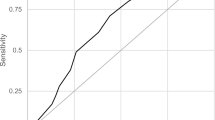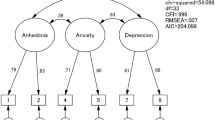Abstract
Psychiatric illness can pose serious risks to pregnant and postpartum women and their infants. There is a need for screening tools that can identify women at risk for postpartum psychosis, the most dangerous perinatal psychiatric illness. This study used exploratory factor analysis (EFA) and Rasch item response theory (IRT) models to evaluate the psychometric properties and construct validity of the Spanish language version of the 16-item Prodromal Questionnaire (PQ-16) as a screening tool for psychosis in a population of pregnant Peruvian women. The EFA yielded a four-factor model, which accounted for 44% of the variance. Factor 1, representing “unstable sense of self,” accounted for 22.1% of the total variance; factor 2, representing “ideas of reference/paranoia,” for 8.4%; factor 3, representing “sensitivity to sensory experiences,” accounted for 7.2%; and factor 4, possibly representing negative symptoms, accounted for 6.3%. Rasch IRT analysis found that all of the items fit the model. These findings support the construct validity of the PQ-16 in this pregnant Peruvian population. Also, further research is needed to establish definitive psychiatric diagnoses to determine the predictive power of the PQ-16 as a screening tool.


Similar content being viewed by others
References
Alegria M, Canino G, Shrout PE, Woo M, Duan N, Vila D et al (2008) Prevalence of mental illness in immigrant and non-immigrant U.S. Latino groups. Am J Psychiatry 165(3):359–369. https://doi.org/10.1176/appi.ajp.2007.07040704
Altshuler LL, Cohen LS, Vitonis AF, Faraone SV, Harlow BL, Suri R, Frieder R, Stowe ZN (2008) The pregnancy depression scale (PDS): a screening tool for depression in pregnancy. Arch Womens Ment Health 11(4):277–285. https://doi.org/10.1007/s00737-008-0020-y
Barrios YV, Gelaye B, Zhong Q, Nicolaidis C, Rondon MB, Garcia PJ, Sanchez PAM, Sanchez SE, Williams MA (2015) Association of childhood physical and sexual abuse with intimate partner violence, poor general health and depressive symptoms among pregnant women. PLoS One 10(1):e0116609. https://doi.org/10.1371/journal.pone.0116609
Bebbington P, Jonas S, Kuipers E, King M, Cooper C, Brugha T, Meltzer H, McManus S, Jenkins R (2011) Childhood sexual abuse and psychosis: data from a cross-sectional national psychiatric survey in England. Br J Psychiatry 199(1):29–37. https://doi.org/10.1192/bjp.bp.110.083642
Bergink V, Rasgon N, Wisner KL (2016) Postpartum psychosis: madness, mania, and melancholia in motherhood. Am J Psychiatry 173(12):1179–1188. https://doi.org/10.1176/appi.ajp.2016.16040454
Bond T, Fox C (2015) Applying the Rasch model: fundamental measurement in the human sciences, 3rd edn. Routledge, New York
Brunoni AR, Benute GR, Fraguas R, Santos NO, Francisco RP, de Lucia MC, Zugaib M (2013) The self-rated inventory of depressive symptomatology for screening prenatal depression. Int J Gynaecol Obstet 121(3):243–246. https://doi.org/10.1016/j.ijgo.2013.01.011
Burgerhout KM, Kamperman AM, Roza SJ, Lambregtse-Van den Berg MP, Koorengevel KM, Hoogendijk WJ et al (2017) Functional recovery after postpartum psychosis: a prospective longitudinal study. J Clin Psychiatry 78(1):122–128. https://doi.org/10.4088/JCP.15m10204
CEMD (2001) Why mothers die 1997–1999. Royal College of Obstetricians and Gynaecologists, London
CEMD (2004) Why mothers die 2000–2002. Royal College of Obstetricians and Gynaecologists, London
Chen F, Wang L, Heeramun-Aubeeluck A, Wang J, Shi J, Yuan J, Zhao X (2014) Identification and characterization of college students with attenuated psychosis syndrome in China. Psychiatry Res 216(3):346–350. https://doi.org/10.1016/j.psychres.2014.01.051
Cox JL, Holden JM, Sagovsky R (1987) Detection of postnatal depression. Development ofthe 10-item Edinburgh Postnatal Depression Scale. Br J Psychiatry 150:782–786
Di Florio A, Forty L, Gordon-Smith K, Heron J, Jones L, Craddock N, Jones I (2012) Perinatal episodes across the mood disorder spectrum. Arch Gen Psychiatry 17(1):1–8
Eaton WW, Kramer M, Anthony JC, Dryman A, Shapiro S, Locke BZ (1989) The incidence of specific DIS/DSM-III mental disorders: data from the NIMH epidemiologic catchment area program. Acta Psychiatr Scand 79(2):163–178
Fonseca-Pedrero E, Gooding DC, Ortuno-Sierra J, Paino M (2016) Assessing self-reported clinical high risk symptoms in community-derived adolescents: a psychometric evaluation of the prodromal questionnaire-brief. Compr Psychiatry 66:201–208. https://doi.org/10.1016/j.comppsych.2016.01.013
Gelaye B, Kajeepeta S, Williams MA (2016) Suicidal ideation in pregnancy: an epidemiologic review. Arch Womens Ment Health 19(5):741–751. https://doi.org/10.1007/s00737-016-0646-0
Hobart JC, Cano SJ, Zajicek JP, Thompson AJ (2007) Rating scales as outcome measures for clinical trials in neurology: problems, solutions, and recommendations. Lancet Neurol 6(12):1094–1105. https://doi.org/10.1016/S1474-4422(07)70290-9
Holcomb WL Jr, Stone LS, Lustman PJ, Gavard JA, Mostello DJ (1996) Screening for depression in pregnancy: characteristics of the Beck depression inventory. Obstet Gynecol 88(6):1021–1025
Ising HK, Veling W, Loewy RL, Rietveld MW, Rietdijk J, Dragt S, Klaassen RMC, Nieman DH, Wunderink L, Linszen DH, van der Gaag M (2012) The validity of the 16-item version of the prodromal questionnaire (PQ-16) to screen for ultra high risk of developing psychosis in the general help-seeking population. Schizophr Bull 38(6):1288–1296. https://doi.org/10.1093/schbul/sbs068
Johnstone L (2011) Can traumatic events traumatise people? Trauma, madness, and ‘psychosis’. In: Rapley M, Moncreiff J, Dillon J (eds) De-medicalising misery: psychiatry, psychology, and the human condition. Palgrave Macmillan, New York
Jones I, Craddock N (2001) Familiality of the puerperal trigger in bipolar disorder: results of a family study. Am J Psychiatry 158(6):913–917. https://doi.org/10.1176/appi.ajp.158.6.913
Kline E, Schiffman J (2014) Psychosis risk screening: a systematic review. Schizophr Res 158(1–3):11–18. https://doi.org/10.1016/j.schres.2014.06.036
Kline E, Thompson E, Bussell K, Pitts SC, Reeves G, Schiffman J (2014) Psychosis-like experiences and distress among adolescents using mental health services. Schizophr Res 152(2–3):498–502. https://doi.org/10.1016/j.schres.2013.12.012
Kroenke K, Spitzer RL, & Williams JB (2001) The PHQ-9: validity of a brief depression severity measure. J Gen Intern Med, 16(9), 606–613
Linacre JM (2017) Ministep Rasch-Model Computer Programs. Winsteps. Retrieved from http://www.winsteps.com/winman/copyright.htm
Loewy RL, Bearden CE, Johnson JK, Raine A, Cannon TD (2005) The prodromal questionnaire (PQ): preliminary validation of a self-report screening measure for prodromal and psychotic syndromes. Schizophr Res 77(2–3):141–149. https://doi.org/10.1016/j.schres.2005.03.007
Meltzer-Brody S, Jones I (2015) Optimizing the treatment of mood disorders in the perinatal period. Dialogues Clin Neurosci 17(2):207–218
Mighton CE, Inglis AJ, Carrion PB, Hippman CL, Morris EM, Andrighetti HJ, Batallones R, Honer WG, Austin JC (2016) Perinatal psychosis in mothers with a history of major depressive disorder. Arch Womens Ment Health 19(2):253–258. https://doi.org/10.1007/s00737-015-0561-9
Morgan C, Gayer-Anderson C (2016) Childhood adversities and psychosis: evidence, challenges, implications. World psychiatry 15(2):93–102. https://doi.org/10.1002/wps.20330
Oates M (2003) Perinatal psychiatric disorders: a leading cause of maternal morbidity and mortality. Br Med Bull 67:219–229
Quispel C, Schneider TA, Hoogendijk WJ, Bonsel GJ, Lambregtse-van den Berg MP (2015) Successful five-item triage for the broad spectrum of mental disorders in pregnancy—a validation study. BMC Pregnancy Childbirth 15:51. https://doi.org/10.1186/s12884-015-0480-9
R Foundation for Statistical Computing (2015) R software (version 3.1.2). Vienna, Austria
Robling SA, Paykel ES, Dunn VJ, Abbott R, Katona C (2000) Long-term outcome of severe puerperal psychiatric illness: a 23 year follow-up study. Psychol Med 30(6):1263–1271
Salokangas RK, Schultze-Lutter F, Hietala J, Heinimaa M, From T, Ilonen T et al (2016) Depression predicts persistence of paranoia in clinical high-risk patients to psychosis: results of the EPOS project. Soc Psychiatry Psychiatr Epidemiol 51(2):247–257. https://doi.org/10.1007/s00127-015-1160-9
SAS Institute (2016) SAS analytics pro 9.4. SAS Institute Inc., Cary
Sit D, Rothschild AJ, Wisner KL (2006) A review of postpartum psychosis. J Women’s Health (Larchmt) 15(4):352–368. https://doi.org/10.1089/jwh.2006.15.352
Souery D, Zaninotto L, Calati R, Linotte S, Mendlewicz J, Sentissi O, Serretti A (2012) Depression across mood disorders: review and analysis in a clinical sample. Compr Psychiatry 53(1):24–38. https://doi.org/10.1016/j.comppsych.2011.01.010
Spitzer RL, Kroenke K., & Williams JB (1999) Validation and utility of a self-report version of PRIME-MD: the PHQ primary care study. Primary Care Evaluation of Mental Disorders. Patient Health Questionnaire. Jama, 282(18), 1737–1744
Spitzer RL, Kroenke K, Williams JB, Löwe B (2006) A brief measure for assessing generalized anxiety disorder: the GAD-7. Arch Intern Med 166(10):1092–1097
Valdimarsdottir U, Hultman CM, Harlow B, Cnattingius S, Sparen P (2009) Psychotic illness in first-time mothers with no previous psychiatric hospitalizations: a population-based study. PLoS Med 6(2):e13. https://doi.org/10.1371/journal.pmed.1000013
VanderKruik R, Barreix M, Chou D, Allen T, Say L, Cohen LS, Maternal Morbidity Working,G (2017) The global prevalence of postpartum psychosis: a systematic review. BMC Psychiatry 17(1):272. https://doi.org/10.1186/s12888-017-1427-7
Weathers F, Huska JA, Keane TM (1991) PCL-C for DSM-IV (trans: Divison BS). National Center for PTSD. Behavioral Science Division, Boston
WHO, UNICEF, UNFPA, World Bank Group, & United Nations (2015) Trends in maternal mortality: 1990 to 2015. World Health Organization, Geneva
Wilkins KC, Lang AJ, Norman SB (2011) Synthesis of the psychometric properties of the PTSD checklist (PCL) military, civilian, and specific versions. Depress Anxiety 28(7):596–606. https://doi.org/10.1002/da.20837
Wilkinson A, Anderson S, Wheeler SB (2017) Screening for and treating postpartum depression and psychosis: a cost-effectiveness analysis. Matern Child Health J 21(4):903–914. https://doi.org/10.1007/s10995-016-2192-9
Acknowledgments
This research was supported by awards from the National Institutes of Health (T32-MH-093310 and R01-HD-059835). The NIH had no further role in study design; in the collection, analysis, and interpretation of data; in the writing of the report; and in the decision to submit the paper for publication. The authors wish to thank the dedicated staff members of Asociacion Civil Proyectos en Salud (PROESA), Peru, and Instituto Materno Perinatal, Peru, for their expert technical assistance with this research.
Author information
Authors and Affiliations
Contributions
Each of the authors has participated sufficiently in the preparation of this manuscript to warrant authorship.
Corresponding author
Ethics declarations
Conflict of interest
The authors declare that they have no conflict of interest.
Research involving human participants
All procedures performed in studies involving human participants were in accordance with the ethical standards of the institutional and/or national research committee and with the 1964 Helsinki declaration and its later amendments or comparable ethical standards.
Informed consent
Informed consent was obtained from all individual participants included in the study.
Rights and permissions
About this article
Cite this article
Levey, E.J., Zhong, QY., Rondon, M.B. et al. The psychometric properties of the 16-item version of the Prodromal Questionnaire (PQ-16) as a screening instrument for perinatal psychosis. Arch Womens Ment Health 21, 563–572 (2018). https://doi.org/10.1007/s00737-018-0833-2
Received:
Accepted:
Published:
Issue Date:
DOI: https://doi.org/10.1007/s00737-018-0833-2




